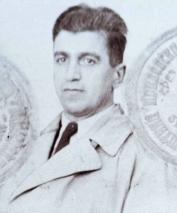Regional Committee of Communists in Macedonia
The Regional Committee of Communists in Macedonia was the provincial communist organization in Vardar Macedonia from 1939 to 1943.
History

At the beginning of 1939, the Central Committee of the
After organising a large demonstration in Skopje in December, Orlandić was arrested and sentenced to one year in prison. In February 1940, a new regional-committee leadership was elected at a meeting; Metodi Shatorov was elected secretary. In June, a national regional-committee program was drawn up. A September 8, 1940 conference was held near Skopje, at which a political resolution was drafted and new leadership was elected. Under Shatorov's leadership, the Macedonian regional committee followed Communist International (Comintern) policy and maintained close ties with Georgi Dimitrov.[2]
After the Bulgarian takeover of
Because of the conflict within the Macedonian CPY regional committee, there was no resistance movement in Vardar Macedonia. The Comintern supported a policy of
CPY loyalists were next appointed as leaders of the RC, with
Sharlo's leadership was terminated, but elements of his policy were preserved by some of the local communist activists. After the arrest of Lazar Koliševski, the new executive body of the Macedonian RC continued to share Shatorov's pro-Bulgarian ideas and re-established contact with the BCP.[9] Bane Andreev of Veles, Macedonia's new party secretary, expressed this ideology. He thought that the Macedonian people believed in Bulgaria's role as liberator, and no Macedonian wanted to fight Bulgarian soldiers; Macedonians should answer the Bulgarian mobilisation call and join the Bulgarian army.[10] Josip Broz Tito, however, disagreed. Bane Andreev was arrested by Bulgarian police in the spring of 1942,[11] worsening the struggle between pro-Bulgarian and pro-Yugoslav factions; Cvetko Uzunovski created a provisional regional committee which attempted to take over the pro-Bulgarian faction, with little success.[12]
Although several Macedonian partisan detachments were formed through the end of 1942 which fought Bulgarian, Italian, German and Albanian occupation forces (and despite Sofia's mismanaged administration), most Macedonian communists were not yet lured to Yugoslavia. Between 1941 and 1943, Tito sent five emissaries to Macedonia to persuade his poorly-disciplined comrades; their efforts had limited success, however, and the regional committee was under the de facto control of the BCP.[13] At the beginning of 1943, the Montenegrin Svetozar Vukmanović ("Tempo") was sent as an assistant to Macedonian partisan headquarters to change that. Tempo tried to organize an energetic resistance and was tasked with setting up a Macedonian communist party within the Yugoslav party. Some of his objectives were to destroy the influence of the BCP in Macedonia and to fight any form of autonomism.
Vukmanović had to
Leadership
- Blažo Orlandić (September 1939 - March 1940)
- Metodi Shatorov (March 1940 - August 1941)
- Lazar Koliševski (September 1941 - November 1941)
- Bane Andreev (November 1941 - May 1942)
- Cvetko Uzunovski (June–September 1942)
- Kuzman Josifovski Pitu (September 1942 - March 1943)
See also
References
- ISBN 954-509-332-3, стр 52.
- ^ Чепреганов, Тодор. Историја на Македонскиот народ, ИНИ, Скопје, 2008, pр. 262–263.
- ISBN 0-8108-3336-0, p. 223.
- ^ "По врвулиците на македонската историја" Иван Катарџиев. Скопје, 1986
- ^ "Зборник докумената и података о народоослободплачком рату jугословенских народа", т. VII, кн. 1, Борбе у Македониjи. Београд, 1952, pp. XII and 22.
- ^ Кои беа партизаните во Македонија Никола Петров, Скопје, 1998
- ^ Vukmanovic Describes Conflict with Bulgarians, Slobodan Stankovic, 11 February 1971, Blinken Open Society Archives
- ^ a b "Вчера и денес: Македонија" Јован Павловски, Мишел Павловски. Скопје, 2000.
- ISBN 9004261915, p. 534.
- ^ Encyclopedia Jugoslavie volume 7, 1955, p. 686.
- ISBN 0810862956, p. 14.
- ISBN 0801421861, pp. 196-197.
- ISBN 0191528722, p. 121.
- , 2013, pp. 469–555.
- ISBN 0208008217, Chapter 9: The encouragement of Macedonian culture.
